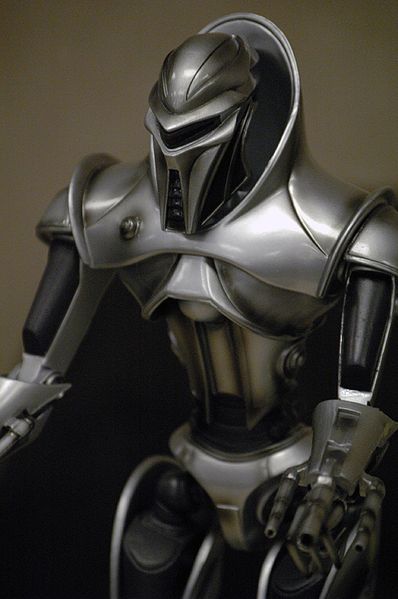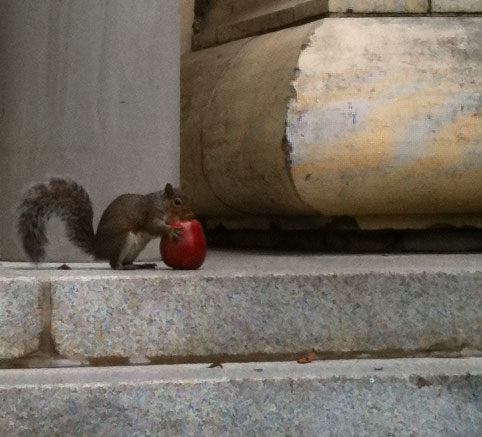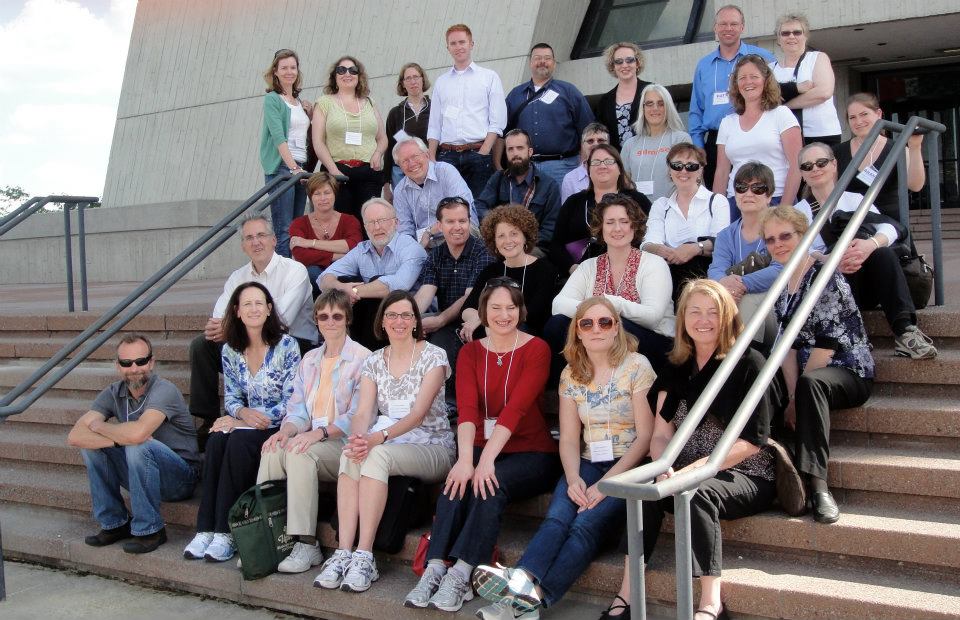You know that word-nerd friend of yours who relishes correcting everyone’s typos and grammatical slip-ups? Now picture dozens of that type in the same place for four days. Yes, that’s the basic scenario of the annual meeting (from which I just returned) of URMA, the University Research Magazine Association, a professional organization for those who write, edit, design, and publish magazines about academic, non-profit, or institute research. If you’re an URMAn (a member of URMA and the wider URMAnity, naturally) the chance to get together with our own kind— pencils sharpened, iPads charged and glowing, and Twitter accounts chirping—is exactly the kind of geeky career development experience we look forward to all year.
I’ll give you a McCutcheon for a Benkovic…
 Justin Verlander, Andrew McCutcheon, Barbara Rolls and Stephen Benkovic. All four of these people have made it to the top of one of life’s pinnacles—they’re featured on trading cards.
Justin Verlander, Andrew McCutcheon, Barbara Rolls and Stephen Benkovic. All four of these people have made it to the top of one of life’s pinnacles—they’re featured on trading cards.
Verlander and McCutcheon are baseball stars. Rolls and Benkovic are stars of a different kind—they’re world renowned Penn State faculty researchers, Rolls in nutrition and Benkovic in chemistry. They are just two of 50 researchers, living and deceased, that the University has touted on a series of trading  cards over the past five years. You can see—and download—all of the cards at the newly created Research Faculty Trading Cards website.
cards over the past five years. You can see—and download—all of the cards at the newly created Research Faculty Trading Cards website.
Dave Pacchioli, of the University Relations office, helped to oversee production and distribution of the cards since their inaugural year. I asked him if anyone associated with the project considered—strictly for the sake of authenticity—inserting sticks of bubble gum into the decks.
“No, but maybe we should have,” he said with a chuckle. He then added, as if discounting this thought on further reflection, “We used clear packaging and you would have seen the gum.”
Gum or no gum, the cards quickly became popular and have enjoyed a wide distribution, both within the Penn State community and externally. In fact, our Research Communications office still occasionally receives inquiries from serious collectors about the cards’ availability. We have a few surplus sets from more recent years. If you’re interested in having one, contact Cathey Chaffee in our office.
It’s easy being green
Kermit the Frog sang “It’s not easy being green,” but on an early summer evening in Central Pennsylvania, when the air is soft and smells of sweet hay, and people’s gardens are shooting up almost as you watch, green can feel like the easiest thing of all.
So it was in Dorothy Blair’s backyard garden a few days ago.
I had interviewed her for a recent Probing Question article on local and organic foods. In one email, she mentioned that she’d just come in from gardening. I can’t resist a garden so I quickly wrote back, “Can I come by and have a look?” and a plan was hatched. Continue reading It’s easy being green
What are you doing Dave?
A while ago I wrote a story about self-replicating, autonomous robots that would clean up debris in our immediate portion of the solar system and then propagate out into the galaxy, returning information and perhaps informing us of our first alien encounter via laser-targeted, light-speed communications. A very futuristic concept and a cool story.
In the course of my interview with John D. Mathews, professor of electrical engineering, I asked him if there were any concerns about these robots — which would also, by necessity, learn — suddenly turning against their makers. I was specifically thinking of the replicators on the TV show Stargate.
Mathew’s response was that some form of Isaac Asimov’s “Three Laws of Robotics” would of course direct the robots:
- A robot may not injure a human being or, through inaction, allow a human being to come to harm.
- A robot must obey orders given it by human beings except where such orders would conflict with the First Law.
- A robot must protect its own existence as long as such protection does not conflict with the First or Second Law.
I pressed a little harder, but Mathews thought that potential problems could be worked out. I don’t doubt him. What struck me is that, when it comes to robots that have any greater intellect than an industrial, repetitive, one-armed, pick-and-place machine, we automatically turned to fiction, science fiction, for references to possibilities and potential hazards.

Running through my mind was HAL of 2001 A Space Odyssey fame going insane, being shut down and slowly and slower singing “Daisy.” What came to mind were both the Replicators and the Cylons that began as obvious machines and eventually took the form of their makers and tried to kill them. Or the robotic house in Demon Seed trying to replicate itself via forced impregnation of the house’s female inhabitant. And even Project 79 in the God Machine, Martin Caidin, who became sentient and tried to take over the world. I remembered all the stories of robot rage, death and destruction.
Mathews on the other hand pulled out the Three Laws. A way for robots to be beneficial to humanity while protecting themselves and a basis for a great many stories about good robots, or at least no worse than most humans robots.
Perhaps it is a case of the glass half full or half empty. I’m not sure. Today, besides industrial robots, the most contact most of us have with a robotic device is a Roomba and they certainly are not sentient. Surgeons do robotic surgery, but that is usually a misnomer. What they are actually doing is teleoperating very small tools. The military also has robot drones, but as far as I know, they too are teleoperated. None of our robots are sentient, yet.
But, an IBM computer managed to beat two of the best Jeopardy champs last year. And beat them soundly. Certainly the machine could not move on its own, and its process of answering was not actual artificial intelligence, but the possession of an enormous amount of available data and the speed to access it. But it is a first step.
Will we some day explore other stars side-by-side with robotic companions, helpers, equals? Will we be able to trust them any more than we would trust a human crewmember? Would it really be all that different?
The neighbors upstairs

For the past year, my boyfriend and I have shared our home with another couple. They lived above us. We could hear them walking around up there, and we suspect we heard them copulating above our own bed. The problem we had with this couple, though, was that they never paid rent. This is probably because they were squirrels.
The situation came to a head a couple of weeks ago. We had been away for the weekend, and came home to discover one of our upstairs neighbors lounging on our couch underneath an afghan. How did he get there, you ask? He fell into a wall, wasn’t able to climb back up into the rafters, and decided to chew his way out through the wall.
Once I got past the trauma of having a squirrel running around my house digging through the aloe plants and cuddling under the blanket my mom crocheted for me, I began to wonder how and why these squirrels chose our attic — of all places — to be. Was this normal? And did we need to worry about squirrel diseases or something haunting our house now?
Who better to ask than our resident squirrel expert, Carolyn Mahan?
A professor of biology at Penn State Altoona, Mahan’s specific area of study is the behavioral ecology of flying squirrels. Nonetheless she was game to talk with me for about half an hour on a Friday afternoon about my Squirrel Situation.
I learned that all species of squirrels either make a drey — a bowl- or ball-nest — or find a cavity to build their nests in — like our house.
“There was probably a gap,” said Mahan, of how the squirrels got into the attic in the first place. “They don’t need a lot of space to get through.”
According to Mahan, squirrels will readily chew through vinyl siding or wood if there is some sort of hole or gap started there already. And in the case of the insulation the squirrels were pulling out of our roof and throwing onto the deck, it most likely was simply in their way.
An important answer I got from the gracious Dr. Mahan: there will be no squirrel diseases haunting our house. The most danger a squirrel poses, Mahan said, is its habit of chewing through plastic coating on wires — which could in turn lead to either an electrocuted squirrel or a fire hazard in the house.
The good news is the squirrel didn’t do much damage in our house — aside from the nice squirrel-sized hole in our bedroom wall. There doesn’t appear to be any wire damage, and we have since patched up the hole that the squirrels were using as their front door.
There are plenty of nice trees in our neighborhood. Maybe they can hang out in one of those?
Tell me about critter escapades in your own home/office/other personal space in the comments section below. I’m sure we’re not the only ones with a ridiculous story to tell!

